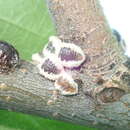Conservation Status
provided by University of Alberta Museums
The impact of the species is mostly aesthetic. Eriococcus spurius does not appear to be capable of causing tree mortality on its own (Dreistadt and Hagen 1994, Williams 1985), although heavy infestations can cause branch dieback, and adults produce honeydew in large amounts (Dreistadt and Hagen, 1994). Nevertheless, E. spurius is considered an invasive pest in parts of North America where it is prevalent, and control of the species has been attempted since the late 1930s, when hymenopteran parasitioids of the species, Coccophagus insidiator (Dalman) was introduced to infested areas in California (Flanders, 1952). The City of Calgary controls E. spurius using pesticides injected into host trees, as well as removal of adults using power washers, a method that can prove effective, although temporary (City of Calgary, 2011).
- license
- cc-by-nc
- copyright
- University of Alberta Museums
Distribution
provided by University of Alberta Museums
First described in Europe in the 1700s (Williams, 1985), the first E. spurius in North American was detected in California in 1893 (Herbert 1924).
- license
- cc-by-nc
- copyright
- University of Alberta Museums
General Description
provided by University of Alberta Museums
A fairly distinct scale insect, adult females are approximately 3 mm long, and 1.8 mm wide, and oval in shape (Williams, 1985). They appear to be dark brown or black, and each individual is surrounded by a white lacelike substance. Closer inspection of individuals removed from the tree reveals that they are in fact a deep, reddish purple hue (Dreistadt and Hagen, 1994). No features other than setae are discernable from the dorsal side, but ventrally, antennae, mouthparts, and vestigial legs are visible.
- license
- cc-by-nc
- copyright
- University of Alberta Museums
Habitat
provided by University of Alberta Museums
This species is restricted to elm trees (genus Ulmus) (Williams, 1985). Since elm trees of any variety are not native to Alberta, the scale is restricted to urban areas where elm trees are planted. Eriococcus spurius is a common pest in Calgary (Mader, 2011), and although periodic outbreaks do occur, heavy infestations do not tend to persist in Edmonton (M. Jenkins, 2011, pers. comm.).
- license
- cc-by-nc
- copyright
- University of Alberta Museums
Life Cycle
provided by University of Alberta Museums
Adult females are sessile, and present on branches, feeding through the bark. They are univoltine, producing eggs in early summer, which hatch into nymphs or "crawlers". These migrate to leaves or young branches upon hatching, where they feed for a portion of the season before migrating back to older branches where they enclose themselves in cocoon-like structures and overwinter without maturing. In the spring, nymphs that have overwintered become adults (Dreistadt and Hagen, 1994). Like most scale insects, males are rare, and females are possibly capable of parthenogenesis (Williams, 1985).
- license
- cc-by-nc
- copyright
- University of Alberta Museums
Trophic Strategy
provided by University of Alberta Museums
Both adults and nymphs feed on elm trees exclusively (Williams 1985). They have been found on a number of elm species, including the English elm (Ulmus procera), Siberian elm (U. pumila), American elm (U. amaricanus) and field elm (U. minor) (Dreistadt and Hagen, 1994). Ulmus pumila appears to be a less suitable host for E. spurius than either U. amaricanus and U. procera, which can be infested with large populations of E. spurius (Dreistadt and Hagen, 1994).
- license
- cc-by-nc
- copyright
- University of Alberta Museums

